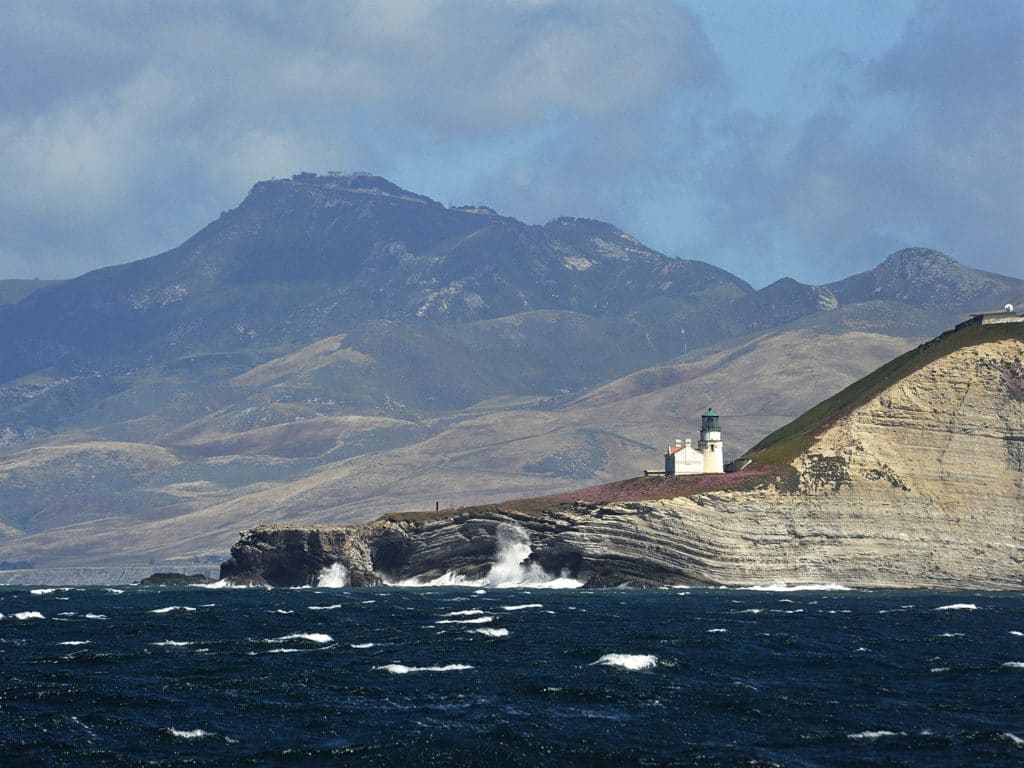
Cruising down the California coast in the long, lazy days of late summer was extremely satisfying. Despite much of the conventional wisdom, the bays and harbors that dot the shore are actually well-situated for comfortable daysailing, and slow-paced mornings segue into exhilarating afternoons galloping ahead of the sea breeze to reach the next anchorage by sundown. As my husband, Neil, and I sailed southward aboard our Liberty 458 sloop, Distant Drummer, we sought out attractions to amuse even the most seasoned cruiser; nature and history provide a wealth of interesting places to explore, the cities are teeming with shopping, and there is a plethora of sights to see from fun parks to film studios.
While cruising in California, I was captivated by the tales of R.H. Dana, who spent two years aboard a Boston brig loading hides between San Francisco and San Diego. His memoir Two Years Before the Mast served as an intriguing cruising guide, and it was interesting to compare our passage of today with his voyage nearly 200 years ago.
Monterey Bay and Point Conception
After a voyage south from Alaska, we had been in the San Francisco Bay area for six weeks, and had explored most of its nooks and crannies. We had cruised up the Delta, hung out around the Bay, and sailed under the Golden Gate Bridge enough times to finally catch it unadorned by its habitual foggy shroud. As we passed under the bridge for the final time, we were graced with a visit from a pair of humpback whales. It was fantastic to watch them surfacing and breaching so close to the entrance to the bay.
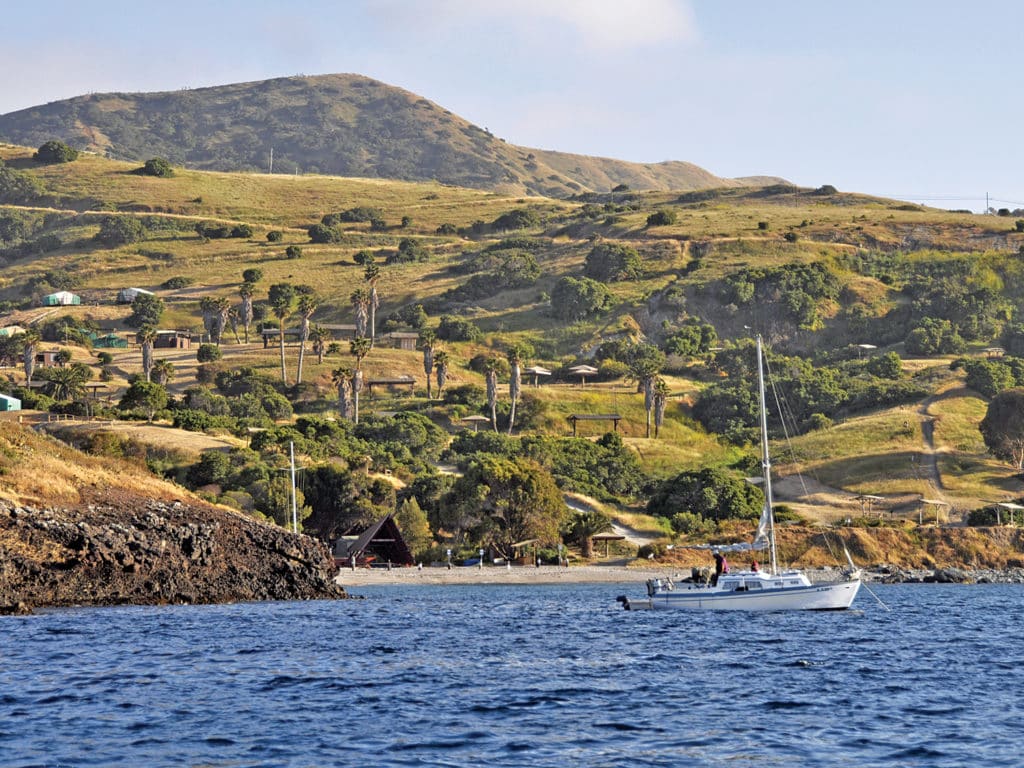
The passage from San Francisco to Monterey was a leisurely three-day cruise, motor-sailing in the gentle morning breeze until a brisk northwesterly filled in during the early afternoon. The first night we tucked in behind the breakwater at Half Moon Bay and stopped for the second night at Santa Cruz. We dropped the hook on the east side of the pier, slap-bang in front of the world-famous Santa Cruz Beach Boardwalk. As an aficionado of fairground kitsch, I rushed ashore to revel in all the fun of the fair. Later, as we tried to sleep, it was not the throbbing music and screams from the amusement park that kept us awake, but the raucous barking and snorting from the sea lion colony beneath the pier.
Crossing the bay to Monterey on a crisp, blue-sky day with a 20-knot breeze on the starboard quarter was magical sailing; we were almost sorry to arrive there. A mooring field occupies the area to the west of Fisherman’s Wharf, so we anchored on the east side and settled in for a calm, clear night. Monterey Harbor is one of the few anchorages that is exposed to winds from the north, but luckily the breeze had backed to the southwest and we were protected behind Point Pinos.
Back in the early-1800s, Monterey was the seat of the Spanish government and boasted the only custom house on the California coast, which can still be found standing in the presidio by the wharf. We sauntered along Cannery Row past the old clapboard sardine-canning factories, which have been renovated and transformed into fashionable shops and restaurants. The town was lively with summer tourists, but we saw no sign of the “cock-fighting, gambling of all sorts, fandangos, and every kind of amusement and knavery” that Dana reported. It’s a shame, really—it sounded like fun!
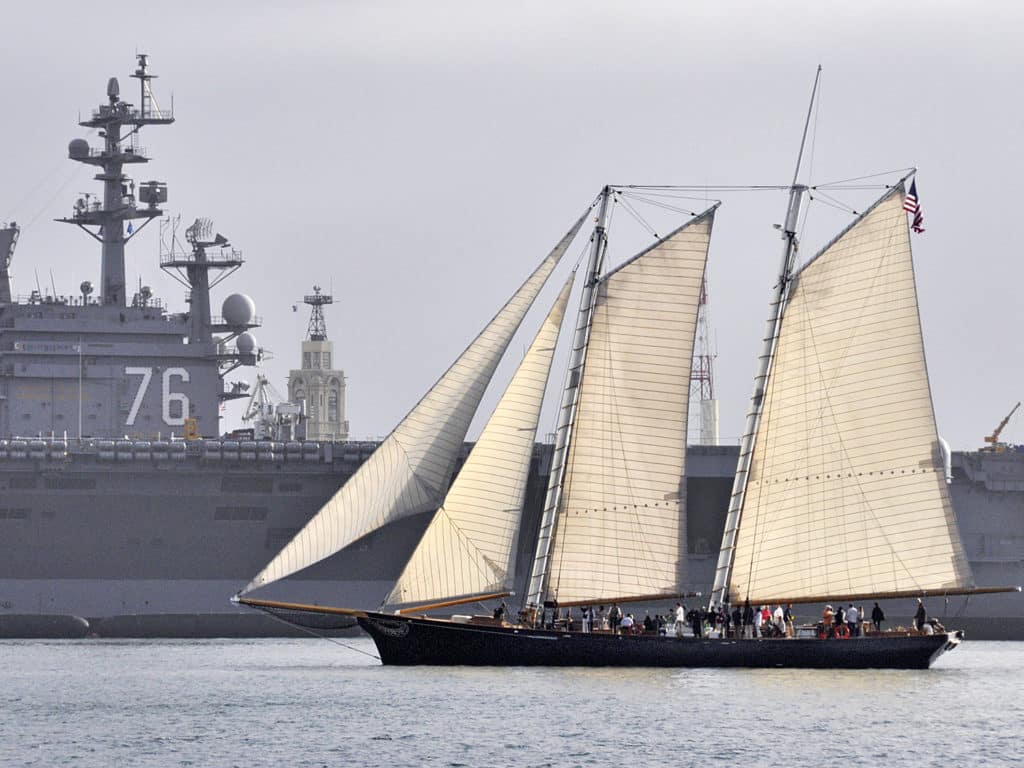
Heading south from Monterey, we had a boisterous overnight passage around Point Sur with a 6-foot swell and the wind gusting over 40 knots on the starboard beam. At sunrise we noticed that a seam close to the top of the mainsail had split, so we decided to stop in Morro Bay to repair it. We slipped through the channel between the sand spit and the peak of Morro Rock, and thankfully dropped the hook in the anchorage area opposite the old power plant. A colony of sea otters lives in Morro Bay, and they are constantly diving and feeding, playing with and nursing their fluffy pups in the tranquil water. Watching their antics provided a perfect distraction as I sat in a billow of canvas stitching the mainsail.
RELATED: Sail to Catalina
Point Conception is a cape with an unhealthy reputation for strong winds and rough water; Dana reported “gales, swept decks [and the] topmast carried away.” We were somewhat luckier, enjoying a beautiful sail from Morro Bay to Santa Barbara in a 15- to 20-knot breeze with a full jib and two reefs in the newly stitched mainsail. We stopped overnight in Cojo anchorage, a small cove that shelters behind Point Conception and has a great view of the lighthouse. It is one of the oldest lighthouses on the California coast but is rarely visited because land access is restricted by the military and a private ranch, so only mariners get to see it.
Santa Barbara and the Channel Islands
Santa Barbara is a day’s sail from Point Conception. The wind was light, but we had the dependable southerly California Current helping us along, and we arrived in time to drop anchor to the east of Stearns Wharf as the sun set. We enjoyed sundowners on the aft deck with a view of the twin towers of the mission peeping out among the whitewashed walls and red-tiled roofs of the town, and the surf pounding on the golden beach.
Santa Barbara is a day’s sail from Point Conception. The wind was light, but we had the dependable southerly California Current helping us along, and we arrived in time to drop anchor to the east of Stearns Wharf as the sun set. We enjoyed sundowners on the aft deck with a view of the twin towers of the mission peeping out among the whitewashed walls and red-tiled roofs of the town, and the surf pounding on the golden beach.
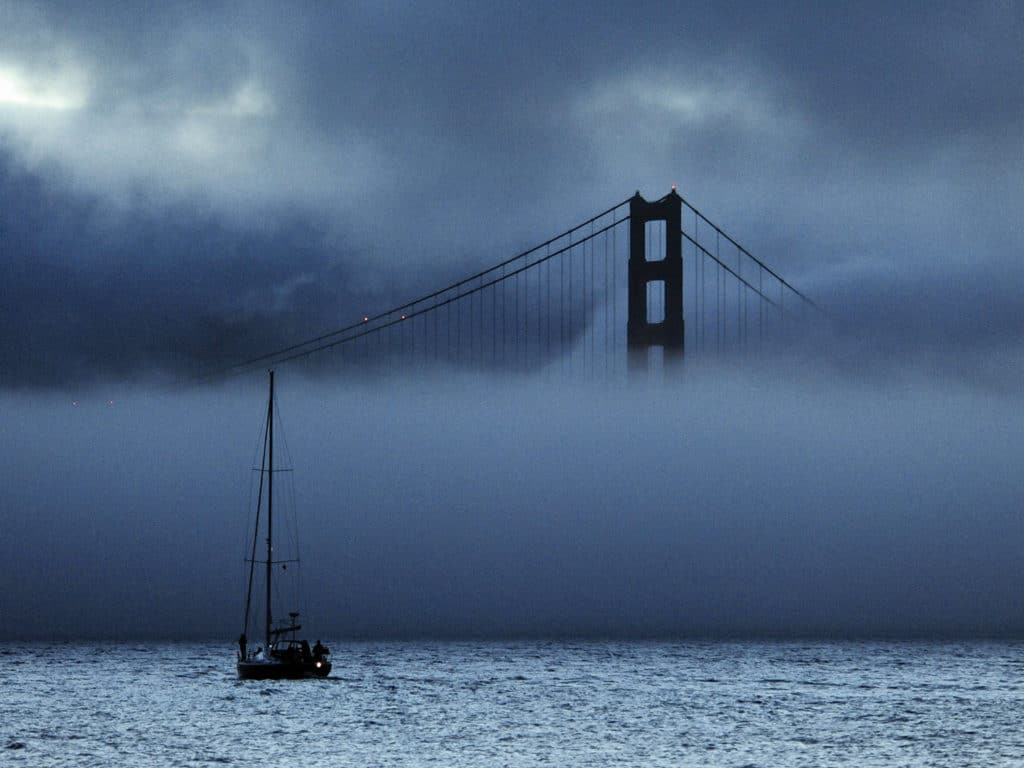
The only downside of being anchored in Santa Barbara was the difficulty in finding a place to land the dinghy to go ashore. The surf makes a beach landing difficult; Dana described a group of Sandwich Islanders as they rowed their boat in to the shore: “They gave three or four long and strong pulls and went in on top of the great wave.” We weren’t quite up for that, and eventually we were able to buy a three-day permit to use the “skiff row” inside the marina.
It was a clear, sunny day when we departed Santa Barbara, and we had a fantastic sail across to the Channel Islands. With just the headsail up, we were flying along nicely in a steady 20-knot sea breeze that blew until the sun went down. Santa Cruz Island is the largest of the group of steep, craggy isles that lie on the south side of the Santa Barbara Channel. We anchored in Pelican Cove, a pocket-size crevice in the sheer cliffs that make up the north coast of the island. The anchorage is exposed to weather from the north, but even a mild westerly swell wrapped around and in to our spot, giving us a slightly rolly night. Pelican Cove has no beach, so getting ashore is hazardous. Instead, we pumped up our inflatable kayak and explored the bay from the water, paddling among dramatic caves and sea arches.
Little Scorpion Cove at the east end of Santa Cruz Island is an imposing anchorage lined with tall cliffs and tottering sea stacks. The water is as clear as gin, and it was mesmerizing to watch the kelp fronds swaying in the swell as it dashed against the rocky islands. We dinghied ashore to a small sandy beach and climbed up the steep path for a walk along the clifftops.
It was a glorious day, the visibility was sensational, and it was wonderful to see Distant Drummer anchored in the bay below and with Anacapa Island fading away into the distance.
Ventura and Santa Monica Bay
As we continued southward down the coast, finding somewhere to drop anchor became more of a challenge. San Diego and the bays of the Channel Islands are the only natural harbors in Southern California. Many ports have an anchorage area behind a breakwater, but anchoring in these zones is often limited to a maximum stay of 72 hours. These areas are patrolled by harbor police who seemed bent on steering us into marinas like sheep into a fold. As an alternative, many yacht clubs in North America have a brilliant system of reciprocity, of which we took advantage. They offer a few days of free moorage and hospitality to cruisers visiting from other clubs, and this provides a great solution to cruising without mounting up huge marina bills.
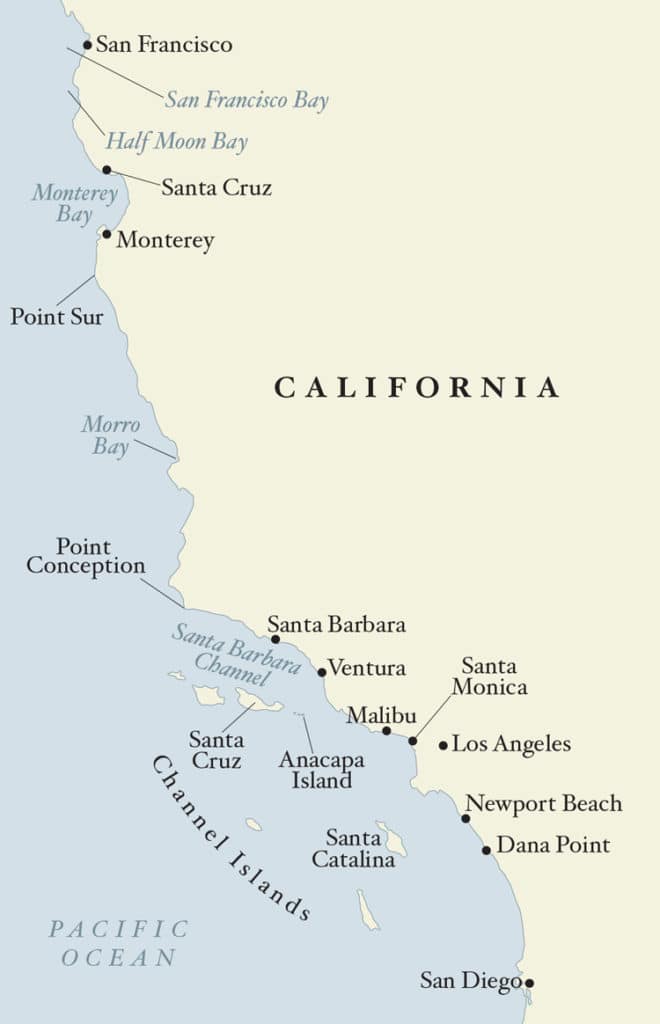
The strong northwest winds that whistle around Point Conception and the western Channel Islands in the summer months tend to die out once they reach the Santa Monica Basin. We recrossed the Santa Barbara Channel from Santa Cruz Island to Ventura, motor-sailing in light airs, and tied up at the Ventura Yacht Club. We received a hearty welcome at the club and an invitation to join in a potluck dinner at the clubhouse that evening. We had a fine time chatting with the locals, listening to a few yarns, and gaining a bit of local knowledge about favorite spots.
We were warned that Point Dume is another headland with a ruthless reputation. The Pacific swells pound through the gaps between the Channel Islands and wrap around Point Dume, making the anchorage at Paradise Cove just behind the point untenable except in the calmest seas. We struck it lucky again with surprisingly serene conditions and spent two fantastic days anchored there. Snorkeling at the point with a couple dozen sea lions was an unforgettable experience. They circled playfully around us and were very curious, often swooping up for a closer look. Their bodies, which seem so cumbersome on land, were lithe and graceful underwater.
The Malibu shoreline between Paradise Cove and Santa Monica is home to some of the hottest real estate in the world; stars including Leonardo DiCaprio, Jack Nicholson and Ellen DeGeneres keep the prices sizzling. As we sailed around the bay to Marina del Rey, we enjoyed gawking through binoculars at the luxurious beach houses and sumptuous palaces in the hills above.
At Marina del Rey, a roadstead anchorage lies close to the entrance channel, however the outer breakwater provides little shelter from the swell, and anchoring there can be pretty rough. Instead we tied up inside the harbor for a few days, first courtesy of the Del Rey Yacht Club and then the California Yacht Club; we were beginning to get the hang of the reciprocal system. Marina del Rey is just south of Venice Beach and Santa Monica, and is an ideal place to leave the boat for a visit to Hollywood and Beverly Hills. We bought a 48-hour hop-on/hop-off bus ticket, climbed up to the open-air top deck, and gorged ourselves on Hollywood craziness.
San Pedro Bay and Catalina Island
It is a short hop down the coast from Marina del Rey to San Pedro, where Dana noted, “There was no sign of a town, not even a house to be seen.” Incredible! Nowadays it has been engulfed by the Los Angeles sprawl. The dock area of San Pedro and neighboring Long Beach is enormous, channeling vast quantities of imported goods into the United States. The harbor in San Pedro has an extensive complex of marinas, but a small corner behind the breakwater has been allocated for anchoring. We dropped the pick there and soon had a visit from the harbor police, who generously gave us a permit to stay for two weeks. This gave us plenty of opportunity to explore the area and share some good times with cruising friends who are based there.
Dana reported that the “rascally hole of San Pedro” (love that description) was unsafe during the violent northeasterly winds that blow out of the desert in fall and winter. These hot, dusty winds are known as Santa Anas, and the west coast of Catalina Island is a great place to shelter from them. It is also a favorite place for Angelinos to unwind on the weekend and, as a consequence, the most popular bays are full of moorings. However, cruising boats can usually find room on the fringes and in the deeper water to drop the hook. We anchored in Catalina Harbor on the west coast and walked across the isthmus to the small community of Two Harbors, which lies on the east side of the island. The red dust and eucalyptus trees reminded us of northern Australia. We propped up the bar in Harbor Reef Restaurant, sipped a couple of icy cold beers, and enjoyed the casual and easygoing pace of island life in the low season.
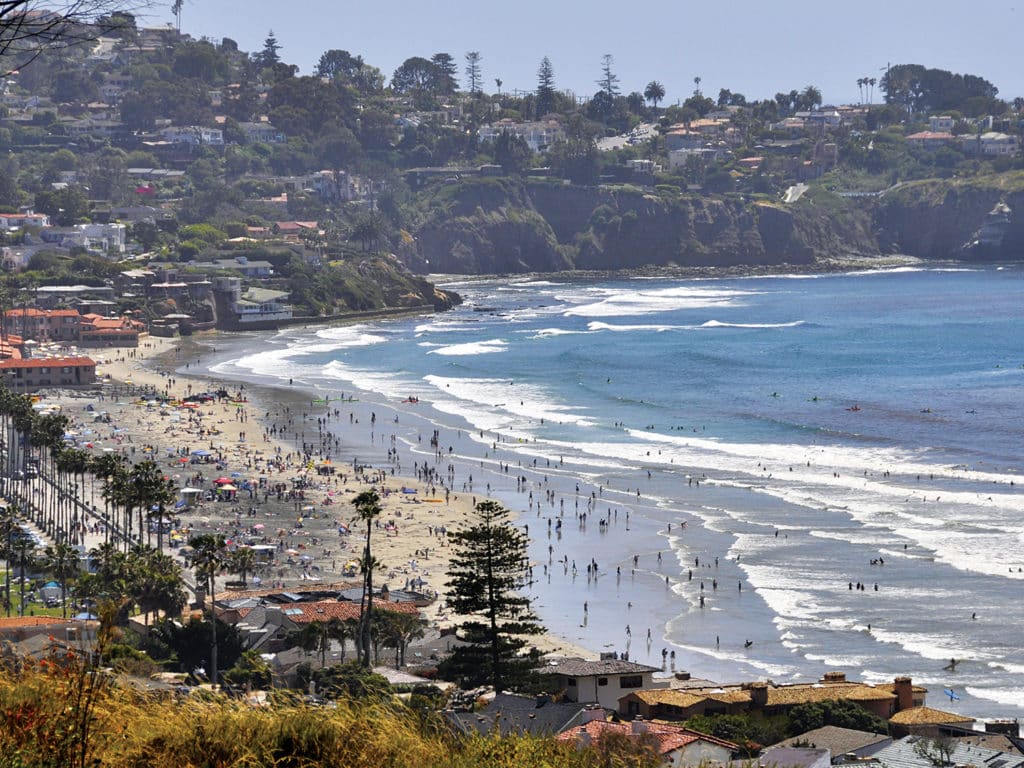
Little Harbor lies south of Catalina Harbor on the west coast. It has no settlement—just a couple of empty beaches, a campsite, and a dirt road connecting it to the rest of the island. In the evening, we went ashore to use the showers, and as we were soaping up, we were startled to see two bison grazing among the palm trees. It was astonishing to see these primeval beasts on a small island just off the Southern California coast. Apparently, 14 bison were brought to the island in 1924 to be extras in a film called The Vanishing American. When the filming finished, so did the money to transport them back to the Great Plains (or so the story goes), but they seem to be thriving in their exile.
The Oil Islands provides another surreal anchoring experience. These are man-made islands that lie off Long Beach Harbor and were constructed in order to develop the Wilmington oil field that underlies San Pedro Bay. The good people of Long Beach liked the money but didn’t like the view of ugly production platforms. So islands with palm trees were built around them, and fake apartment buildings were erected to disguise the unsightly drilling derricks. Although anchoring is allowed behind White Island only on weekends, the Oil Islands offers a bizarre alternative to tying up in a marina.
Dana Point and San Diego
After a couple of weeks of happy gunkholing in San Pedro Bay, we departed for San Diego, the last leg of our California cruise. A light wind was blowing from the southeast, and we tacked laboriously between container ships and the Oil Islands. We passed Newport Beach, where the coastline begins to rise and high cliffs replace the famous sunbaked Californian beaches. After a hard day of tacking, we reached Dana Point and decided to call it a day, hoping for better wind in the morning. The bay at Dana Point is protected by a long breakwater and is almost completely full of marina berths. There is a small anchoring area behind the breakwater, but we enjoyed a reciprocal night at the dock courtesy of the Dana Point Yacht Club.
Dana Point is the zenith of Dana lore; statues of him abound around the town, and a reproduction of the brig Pilgrim lies in the bay. He is immortalized for an incident that happened at San Juan while they were collecting and loading hides. Dana wrote that tossing the hides from the bluffs down to the beach was much quicker than carrying them down the dangerous cliff path. When a hide got stuck part way down the cliff, he was lowered down “by a pair of top-gallant studding-sail halyards” to dislodge it. In doing so, he became a bit of a local legend, and the area previously known as San Juan was renamed Dana Point.
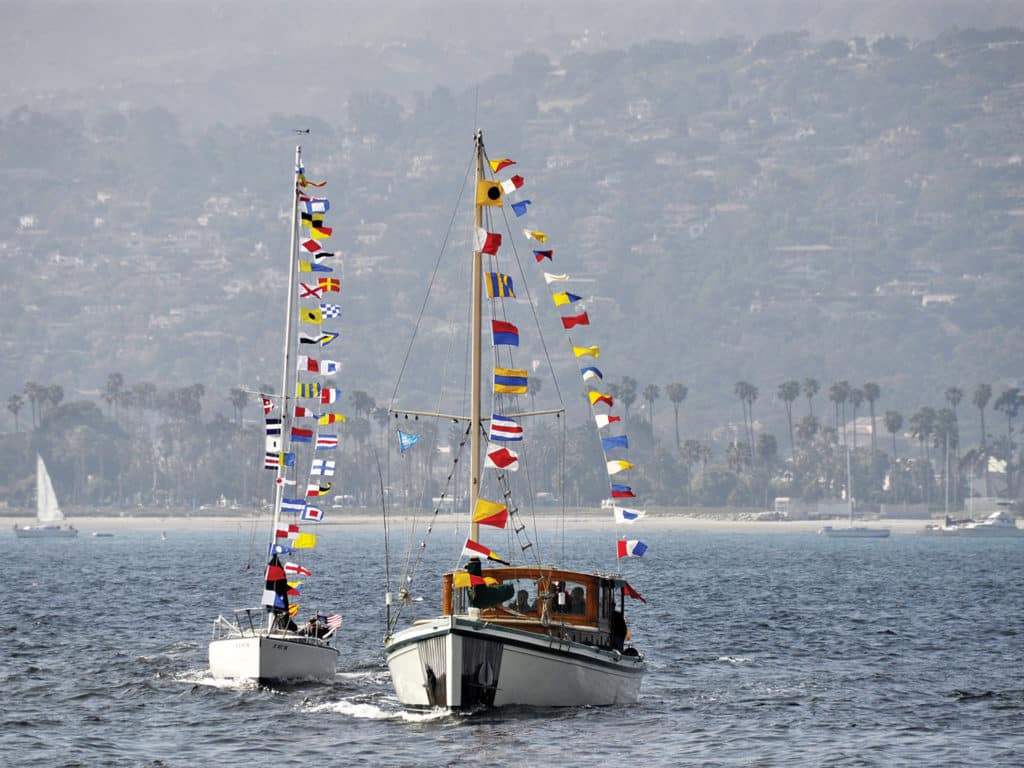
When we woke the next day, the wind had veered to a robust southwesterly, and we had a glorious sail down to Mission Bay—a large, shallow inlet that lies just to the north of the city of San Diego. Low bridges prevent sailboats from accessing most of the bay, but Mariners Cove is a lagoon close to the entrance channel, and it’s where we found a spot to anchor. Sipping sundowners in this tranquil cove while basking in the golden light of the setting sun was heavenly. The next day we rounded Point Loma, giving it a wide berth because of the kelp field on its seaward side, and passed through the channel into San Diego Bay.
Dana considered San Diego to be “the best harbor on the coast, being completely land-locked, and the water as smooth as a duck pond.” These days, the duck pond behind the sandbar is filled with container ships and naval vessels, superyachts and sailboats. The anchorage rules in San Diego require visiting boats to be inspected for safety and seaworthiness at the Harbor Police Dock. Having passed inspection, we were issued a 30-day permit for the A-9 Cruisers Anchorage that is located conveniently close to downtown. From the anchorage, it is just a stroll along the waterfront to reach the Maritime Museum and USS Midway, and a short walk up the hill to the San Diego Zoo in Balboa Park. The downside of the anchorage is that it is located adjacent to the runway of the international airport, and the noise pollution is off the scale.
The late-summer and early-fall months were a perfect time to be cruising southward down the California coast. Although the winds were often light, we could rely on the afternoon sea breeze to switch on the turbo, and on our good buddy, the south-setting California Current, to keep us moving in the right direction. We greatly appreciated the yacht-club reciprocal-membership system, and give a big shout-out to the clubs that generously hosted us along the way. In the 200 years since Dana visited California, mega-metropolises have mushroomed in once-deserted bays. Harbors are now cluttered with marinas and anchoring rules, but for the most part, we were pleasantly surprised to learn that there is still room for the freedom-loving cruiser to swing on the anchor and be delightfully content.
After purchasing Distant Drummer in Thailand 13 years ago, Suzy and Neil Carmody have crossed the Pacific, and sailed down the West Coast from Alaska to Panama. This year they will transit the Panama Canal to cruise the Caribbean. For more on their adventures and tips on living aboard, visit their blog.








